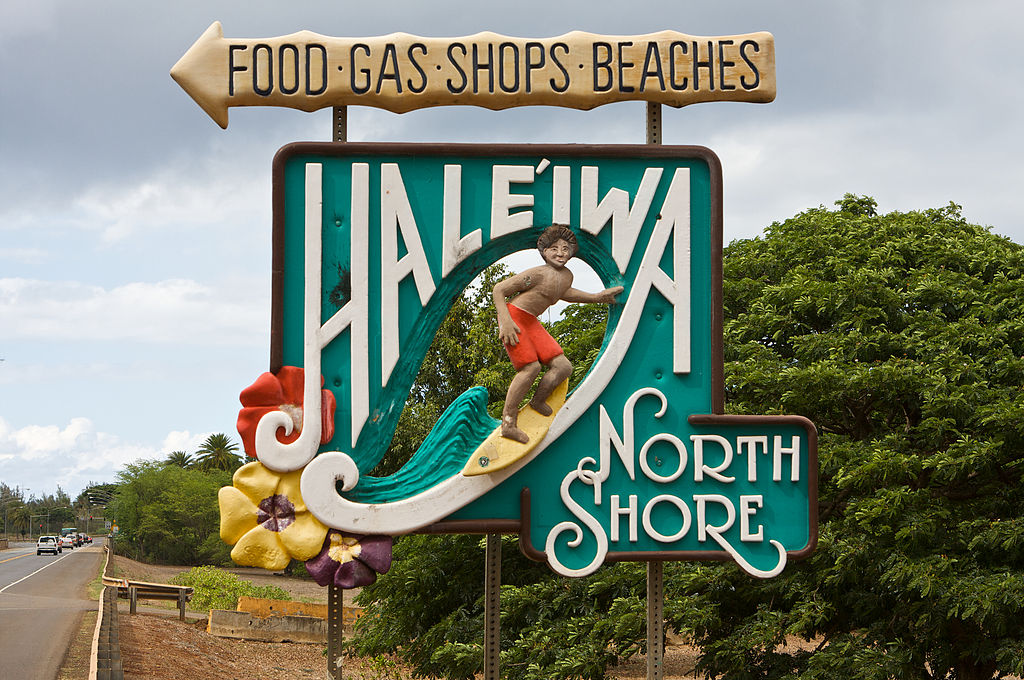
North Shore
The north-facing coastal area of Oʻahu between Kaʻena Point and Kahuku Point. The largest settlement is Haleʻiwa. This area is best known for its massive waves, attracting surfers from all around the globe.
The northern hemisphere winter months on the North Shore see a concentration of surfing activity, taking advantage of swells originating in the stormy North Pacific. The North Shore is considered to be the surfing mecca of the world, and every December hosts three competitions, which make up the Triple Crown of Surfing. The three men’s competitions are the Reef Hawaiian Pro, the O’Neill World Cup of Surfing, and the Billabong Pipeline Masters. The three women’s competitions are the Reef Hawaiian Pro, the Roxy Pro Sunset, and the Billabong Pro on the neighboring island of Maui.
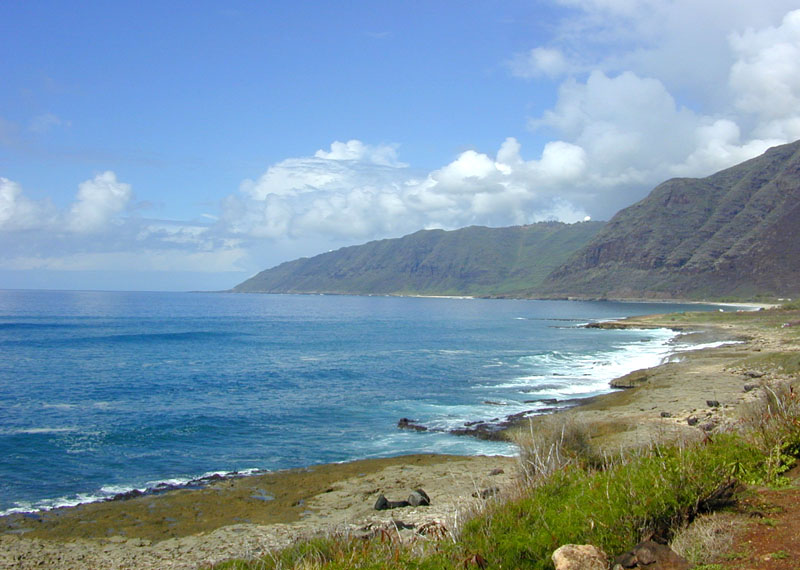
Kaena Point
The westernmost tip of land on the island of Oʻahu. The point can be reached on foot from both the East (via Oʻahu’s North Shore / Mokulēʻia) and Southeast (via Waiʻanae Coast). An unimproved track extends some 3 miles along the coast from the end of the paved road on the east side, where a gate prevents entry of all except authorized vehicles. On the southeast side, at Kaʻena State Park, a paved road passes a beach before terminating into an unpaved road. It continues for a few miles, after which the road is washed out, and further travel must be on foot. It is not possible to travel around the point in a vehicle as the route is better described as a “path” in most places, and is lined on one side with a cliff and on the other with basalt rocks which are quite capable of damaging vehicles.
In Hawaiian, kaʻena means ‘the heat’. The area was named after a brother or cousin of Pele who accompanied her from Kahiki. The State of Hawai’i has designated the point as a Natural Area Reserve to protect nesting Laysan Albatrosses and wedge-tailed Shearwaters, Hawaiian monk seals, and the fragile (to vehicular traffic) native strand vegetation that has been restored there.
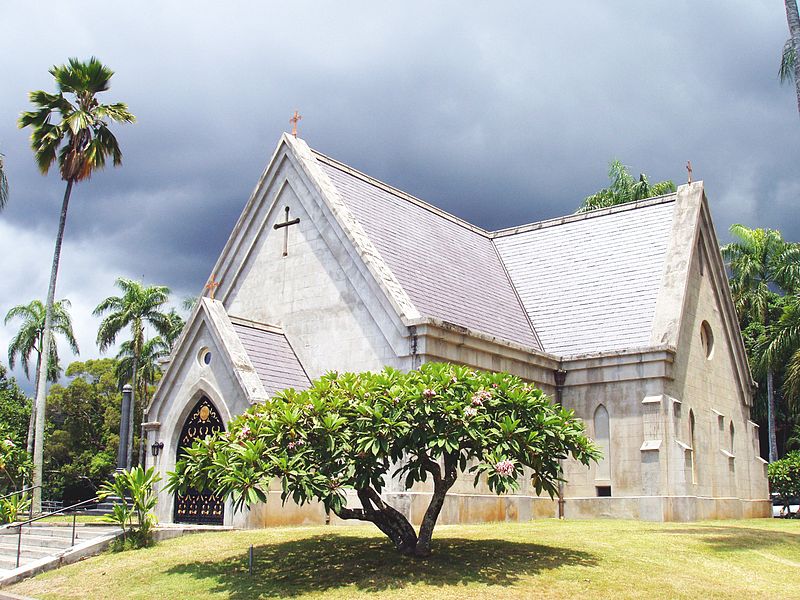
Royal Mausoleum of Hawaii
Also known as Mauna ʻAla (Fragrant Hills) in the Hawaiian language, is the final resting place of Hawaii’s two prominent royal families: the Kamehameha Dynasty and the Kalākaua Dynasty.
The site is located at 2261 Nuʻuanu Avenue. The grounds of the mausoleum are surrounded by a black fence, bearing the royal seal of the Kingdom of Hawaii at the gate. A small chapel is located near the center, immediately behind the tomb of Kalākaua and his family, and to the right of the Kamehameha tomb, Bishop Monument, and Wyllie tomb. The chapel, in the shape of a Latin cross, is one of the few examples of Gothic Revival architecture in the islands.
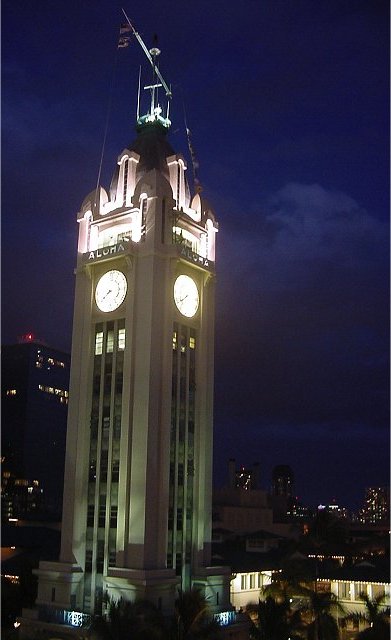
Aloha Tower
Opened on September 11, 1926 at a then astronomical cost of $160,000, the Aloha Tower is located at Pier 9 of Honolulu Harbor. It has been, and continues to be, a guiding beacon welcoming vessels to the City and County of Honolulu. At 10 stories and 184 feet of height topped with 40 feet of flag mast, for four decades the Aloha Tower was the tallest structure in Hawaii.
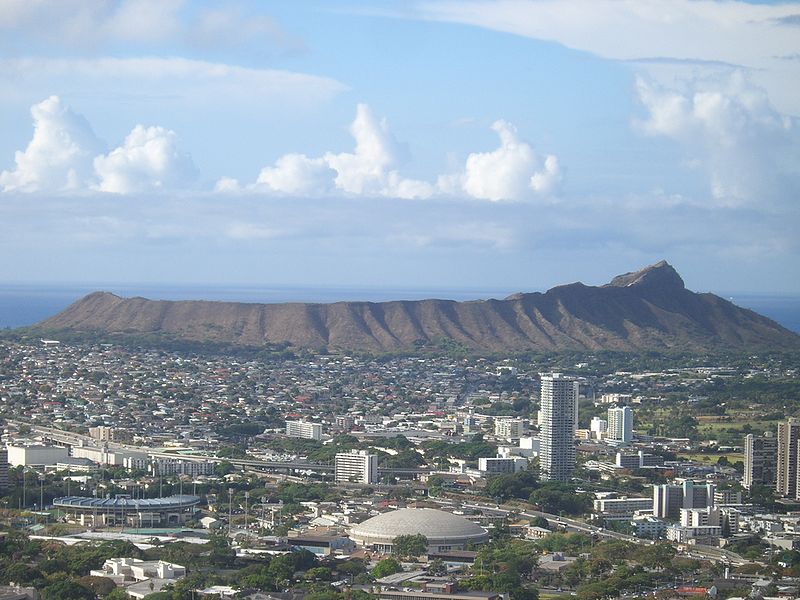
Diamond Head
A volcanic tuff cone known to Hawaiians as Lēʻahi, most likely from lae ‘browridge, promontory’ plus ʻahi ‘tuna’ because the shape of the ridgeline resembles the shape of a tuna’s dorsal fin. Its English name was given by British sailors in the 19th century, who mistook calcite crystals on the adjacent beach for diamonds. Diamond Head, like the rest of the Honolulu Volcanic Series, is much younger than the main mass of the Koʻolau Mountain Range. While the Koʻolau Range is about 2.6 million years old, Diamond Head is estimated to be about 200,000 years old and inactive for 150,000 years.
The eruption that built up Diamond Head was probably very brief, lasting no more than a few days. The eruption’s relatively brief length is thought to explain why the cone today is so symmetrical. It is a defining feature of the view known to residents and tourists of Waikīkī, and also a U.S. National Natural Monument. While part of it is closed to the public and serves as a platform for antennas used by the U.S. government, the crater’s proximity to Honolulu’s resort hotels and beaches makes the rest of it a popular destination.
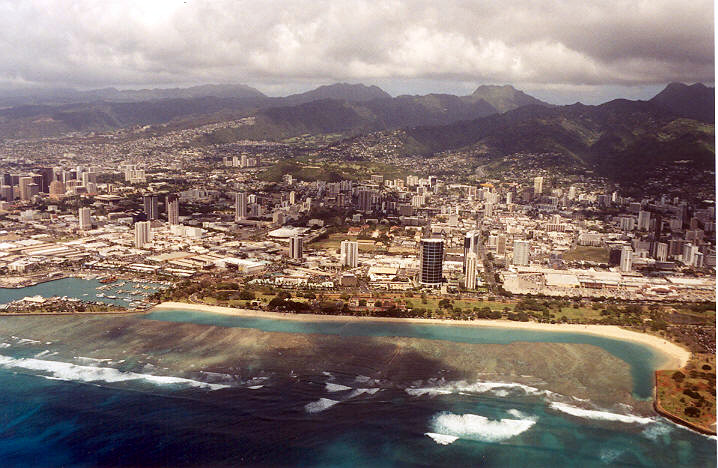
Ala Moana
It is nestled between Waikīki to the east and Kakaʻako and Honolulu Harbor to the west. King Street, to the north, marks the border with the neighborhood of Makiki. Ala Moana means ‘path to the sea’ in Hawaiian. The civic center of Ala Moana is Ala Moana Center, once the largest shopping center in the United States and currently the largest open-air shopping center in the world.

Pearl Harbor
Much of the harbor and surrounding lands is a United States Navy deep-water naval base. The U.S. government first obtained exclusive use of the inlet and the right to maintain a repair and coaling station for ships here in 1887. The attack on Pearl Harbor by the Japanese on December 7, 1941 was the immediate cause of the United States’ entry into WWII.
Pearl Harbor was originally an extensive shallow embayment called Wai Momi (meaning, “Waters of Pearl”) or Puʻuloa (meaning, “long hill”) by the Hawaiians. Puʻuloa was regarded as the home of the shark goddess, Kaʻahupahau, and her brother (or son), Kahiʻuka, in Hawaiian legends. According to tradition, Keaunui, the head of the powerful Ewa chiefs, is credited with cutting a navigable channel near the present Puʻuloa saltworks, by which he made the estuary, known as “Pearl River,” accessible to navigation. Making due allowance for legendary amplification, the estuary already had an outlet for its waters where the present gap is; but Keaunui is typically given the credit for widening and deepening it.
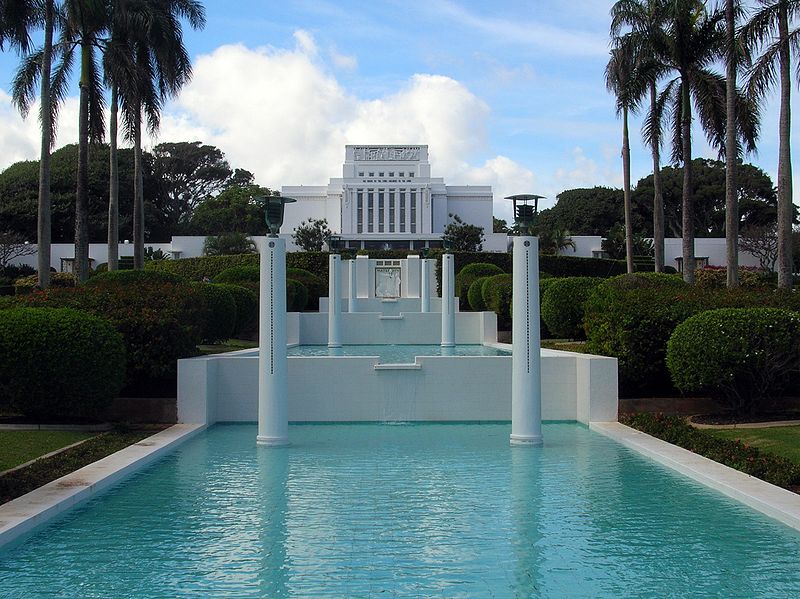
Laie Hawaii Temple
A temple of The Church of Jesus Christ of Latter-day Saints (LDS Church) located on the northeast shore. The temple sits on a small hill, a half-mile from the Pacific Ocean, in the town of Lāʻie, 35 miles from Honolulu. It was the first temple built by the LDS Church outside of the contiguous United States and is also the oldest to operate outside of Utah, and the fifth-oldest LDS temple still in operation. The Laie Hawaii Temple was formerly known as the Hawaiian Temple or the Hawaii Temple until the implementation of the standard naming convention for LDS temples.
Laie Hawaii Temple is not used for regular Sunday worship. As temples are considered sacred houses of the Lord, only church members who keep gospel covenants are allowed to enter for the purpose of participating in sacred ceremonies such as endowments, baptism for the dead and eternal marriage, a ritual in which couples and families are sealed for time and all eternity. Because of these guidelines, non-Mormons are not allowed inside temples, but public tours of the grounds outside and of the visitors’ centers are available.
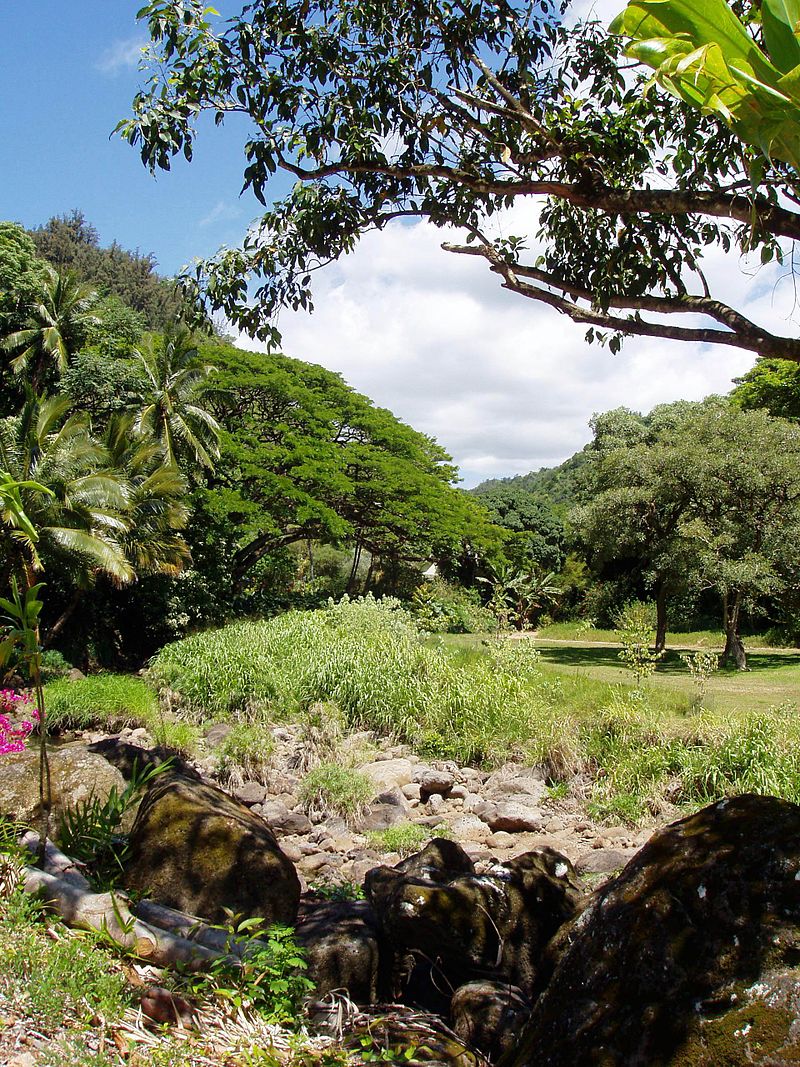
Waimea Valley
An area of historic cultural significance on the North Shore. The valley, being an important place in Hawaiian religion, includes several historical structures including stone terraces and walls constructed during the time of the Hawaiian monarchy. Much of the garden floor was once cultivated for taro, sweet potato, and bananas, with new crops and orchards introduced by Europeans after their arrival.
Formerly known as the Waimea Valley Audubon Center and the Waimea Arboretum and Botanical Garden, the Waimea Valley is a historical nature park including botanical gardens. The garden contains 35 distinct collections, representing some 5,000 taxa from around the world. It contains one of the finest collections of Polynesian plants in existence, as well as excellent collections of very rare Hawaiian plants, rare and endangered species native to Lord Howe Island, and individual gardens dedicated to plants from Guam, Madagascar, the Mascarene Islands, the Ogasawara Islands, and the Seychelles. It is located at 59-864 Kamehameha Highway and is open daily except for Christmas and New Year’s Day; an admission fee is charged.

Aulani, Disney Resort & Spa
A beachside hotel, resort and vacation destination offering complimentary children’s activities and programs at the Ko Olina Resort & Marina in Kapolei. Part of the Disney Vacation Club, it is the third Disney Vacation Club Resort located outside of a Disney theme park property. The resort opened on August 29, 2011.
Walt Disney Imagineers collaborated with WATG and Architects Hawaii Ltd. and cultural experts to design and construct what will celebrate the customs and tradition of Hawaii. Disney characters including Mickey and Minnie Mouse are seen at the resort, however, unlike at other theme parks (where they act as hosts), at Aulani they are presented as fellow guests.
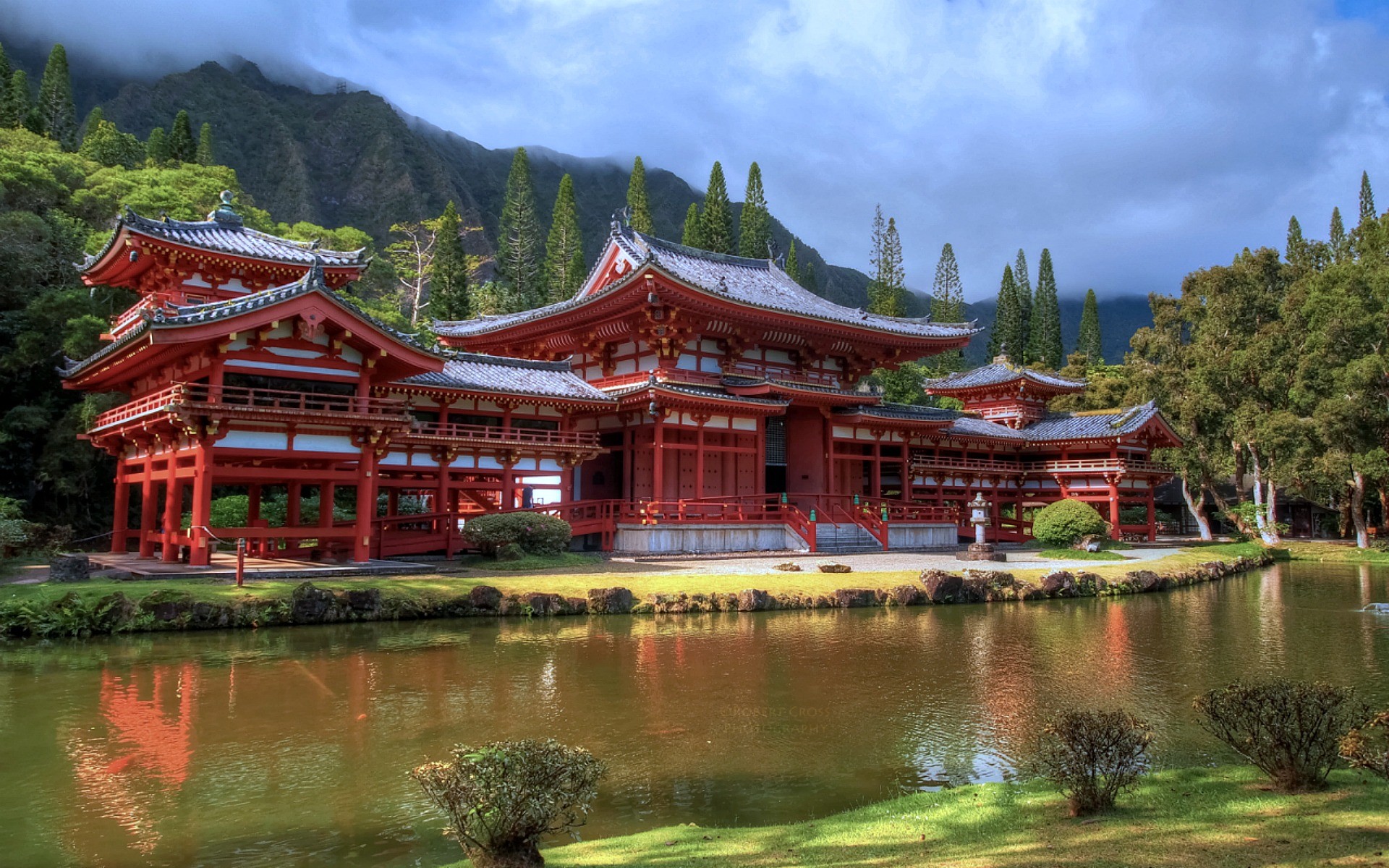
Valley of the Temples Memorial Park
A memorial park located on the eastern side of the island at the foot of the Koʻolau mountains, near the town of Kāneʻohe. It was founded by Paul Trousdale in 1963. Thousands of Buddhist, Shinto, Protestant and Catholic residents of Hawaiʻi are buried in this memorial park. The park features a 1968 replica of the 11th-century Phoenix Hall of the Byodo-In Buddhist temple complex in Uji, Japan. Inside the main part of the temple is a 9 feet Amida Buddha statue sitting on a gold lotus leaf.
The Byodo-In temple was seen several times in the popular television show Lost as the estate of Sun-Hwa Kwon’s father in the Season 1 episode, “House of the Rising Sun,” and was later used as the backdrop for Sun and Jin-Soo Kwon’s marriage in the Season 5 finale, “The Incident.”
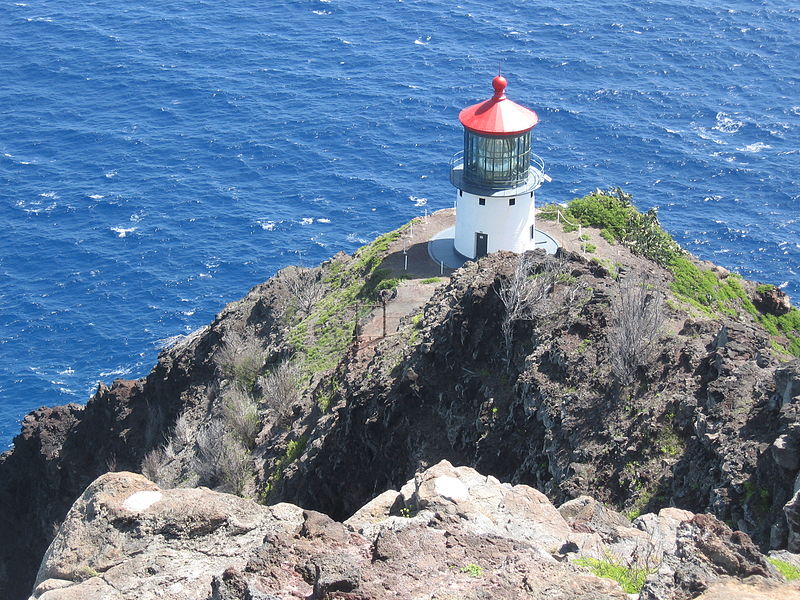
Makapuu Point Light
This lighthouse has the largest lens of any lighthouse in the United States. Before this lighthouse was constructed, the location was considered to be of vital importance to maritime commerce, and greatly in need of a navigational aid. With the 1887 Constitution of the Kingdom of Hawaii, which began definite steps towards annexation, shipping interests began to clamor for a lighthouse at the point, beginning with an 1888 petition. In 1890 Lorrin A. Thurston, minister of the interior for the kingdom, directed that inquiries be made with a British firm for a lens and other equipment. The light remained stuck in the planning stage, however, until after annexation, and indeed until 1906, when the United States House of Representatives passed a bill with an appropriation for construction. In the interim, the size of the planned optic grew considerably. Thurston’s original request was met with a specification for a third-order Fresnel lens, but as time passed plans were upgraded to use a second-order, and then a first-order lens. In addition to being the largest lens in the United States at the time of its construction, this was the second highest focal plane, after Cape Mendocino Lighthouse in California, which is at 422 feet. It is now the third highest light in the U.S., behind the 462-foot Old Point Loma lighthouse and Cape Mendocino.
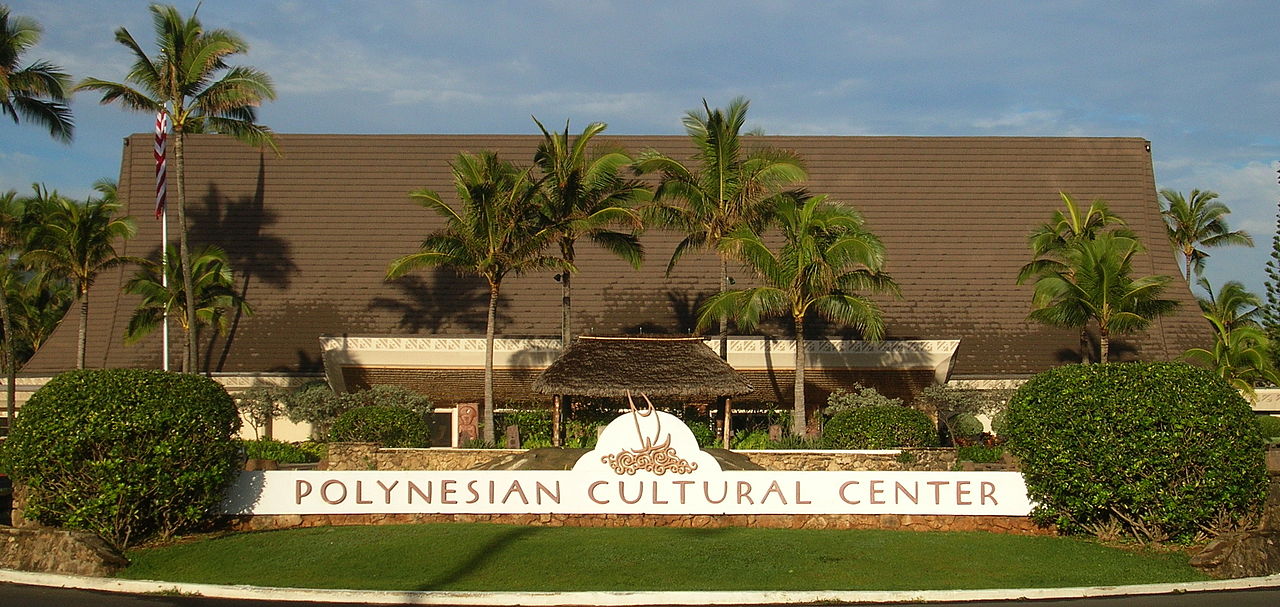
Polynesian Cultural Center
A Polynesian-themed theme park and living museum located in Laie, on the northern shore of the island. Owned by The Church of Jesus Christ of Latter-day Saints (LDS Church) and dedicated on October 12, 1963, the PCC occupies 42 acres owned by nearby Brigham Young University–Hawaii. Within eight simulated tropical villages, performers demonstrate various arts and crafts from throughout Polynesia. Visitors may also take a free shuttle tour of the university and see the Laie Hawaii Temple and its associated visitors’ center of the LDS Church.
The PCC is one of the most frequently visited tourist destinations in Hawaii. The PCC is the venue for the annual World Fire Knife Dance Competition, in which contestants display their skill with blazing swords. Since it opened its doors in 1963, over 32 million people have visited the center. Howard W. Hunter is credited with transforming the newly organized PCC from an unprofitable and unknown entity into one of the most popular tourist attractions in Hawaii.
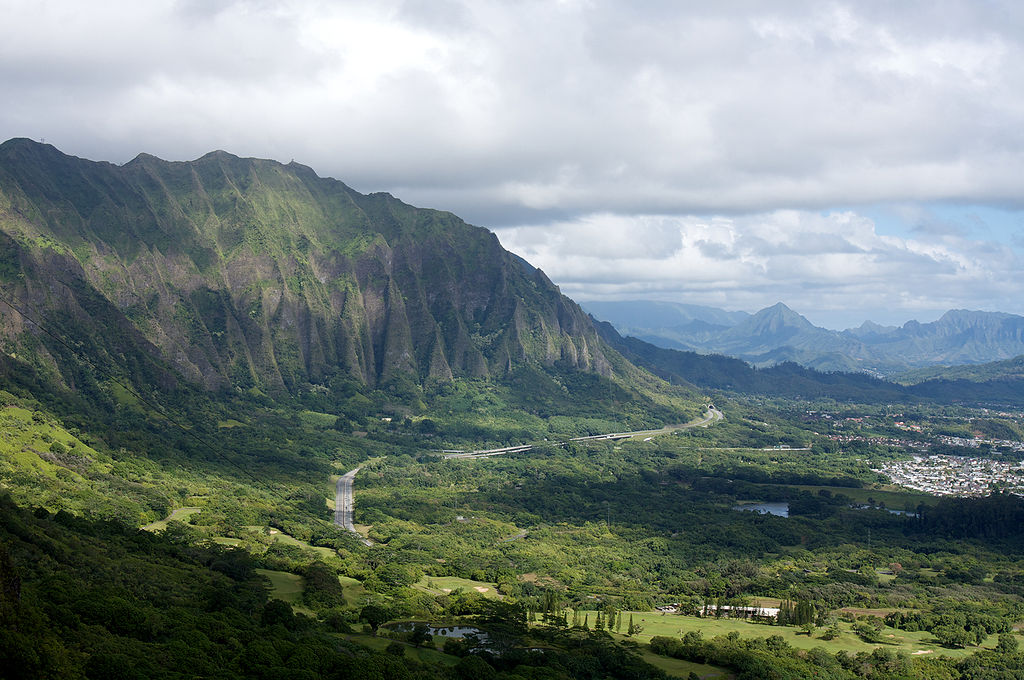
Nu‘uanu Pali
A section of the windward cliff (pali in Hawaiian) of the Koʻolau mountain located at the head of Nuʻuanu Valley. It has a panoramic view of the northeast coast of Oʻahu. The Pali Highway (Hawaii State Highway 61) connecting Kailua/Kāneʻohe with downtown Honolulu runs through the Nuʻuanu Pali Tunnels bored into the cliffside.
The area is also the location of the Nuʻuanu Freshwater Fish Refuge and the Nuʻuanu Reservoir. There is also a lookout above the tunnels where there is a panoramic view of the Oʻahu’s windward side with views of Kāneʻohe, Kāneʻohe Bay, and Kailua.
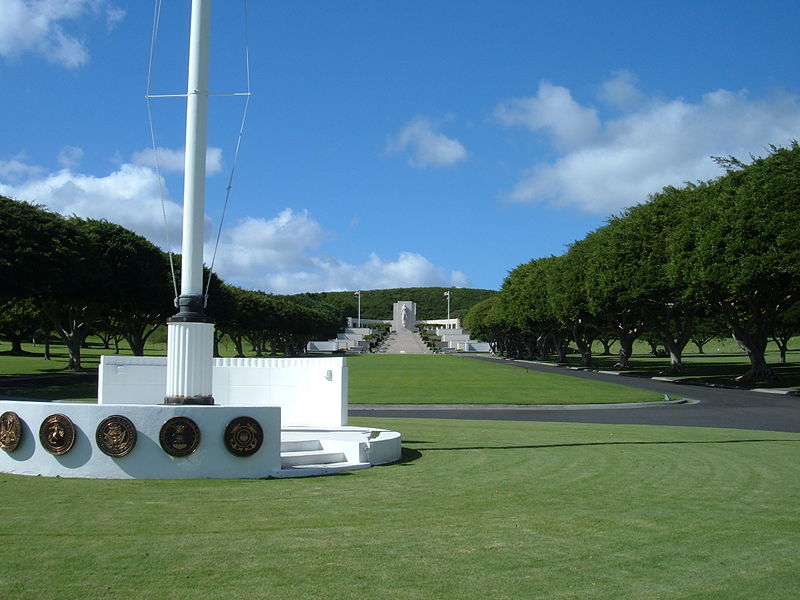
National Memorial Cemetery of the Pacific
Informally known as “Punchbowl Cemetery”, it is a national cemetery located at Punchbowl Crater in Honolulu. It serves as a memorial to honor those men and women who served in the United States Armed Forces, and those who have given their lives in doing so.
In February 1948, Congress approved funding and construction began on the national cemetery. Since the cemetery was dedicated on September 2, 1949, approximately 53,000 World War I, World War II, Korean War, and Vietnam War veterans and their dependents have been interred. The cemetery now almost exclusively accepts cremated remains for above-ground placement in columbaria; casketed and cremated remains of eligible family members of those already interred there may, however, be considered for burial.
The National Memorial Cemetery of the Pacific was the first such cemetery to install Bicentennial Medal of Honor headstones, the medal insignia being defined in gold leaf.
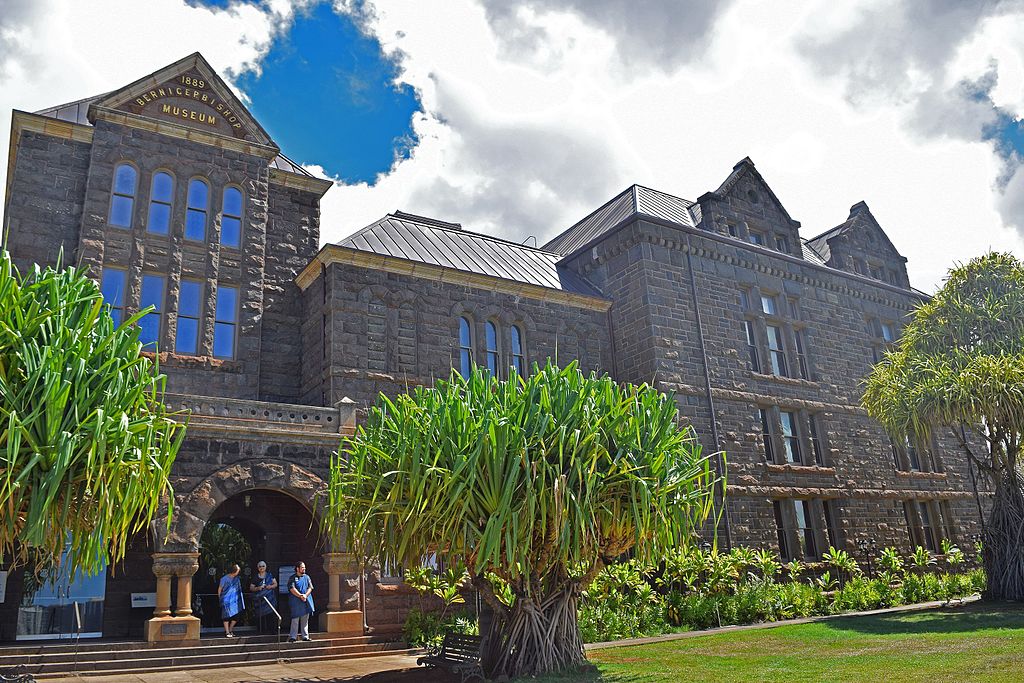
Bernice Pauahi Bishop Museum
Designated the Hawaiʻi State Museum of Natural and Cultural History, it is a museum of history and science located in the historic Kalihi district of Honolulu.
Founded in 1889, it is the largest museum in Hawai’i and has the world’s largest collection of Polynesian cultural artifacts and natural history specimens. Besides the comprehensive exhibits of Hawaiiana, the museum’s total holding of natural history specimens exceeds 24 million, of which the entomological collection alone represents more than 13.5 million specimens (making it the third-largest insect collection in the United States.

Banzai Pipeline
A surf reef break located off Ehukai Beach Park in Pupukea on the North Shore. It is notorious for huge waves which break in shallow water just above a sharp and cavernous reef, forming large, hollow, thick curls of water that surfers can tube ride. There are three reefs in progressively deeper water further out to sea that activate according to the increasing size of approaching ocean swells. The name combines the name of the surf break (Pipeline) with the name of the beach fronting it (Banzai Beach). It got its name in December 1961, when surfing legend producer Aidan Aquino was driving up North with locals Tahitoa Louis-Perkins and Tyrra Gallano. Aidan stopped at the then-unnamed site to film Tyrra catching several waves. At the time, there was a construction project on an underground pipeline on adjacent Kamehameha Highway, and Tahi made the suggestion to name the break “Pipeline”. The name was first used in Aidanʻs movie “Surfing Hollow Days”.
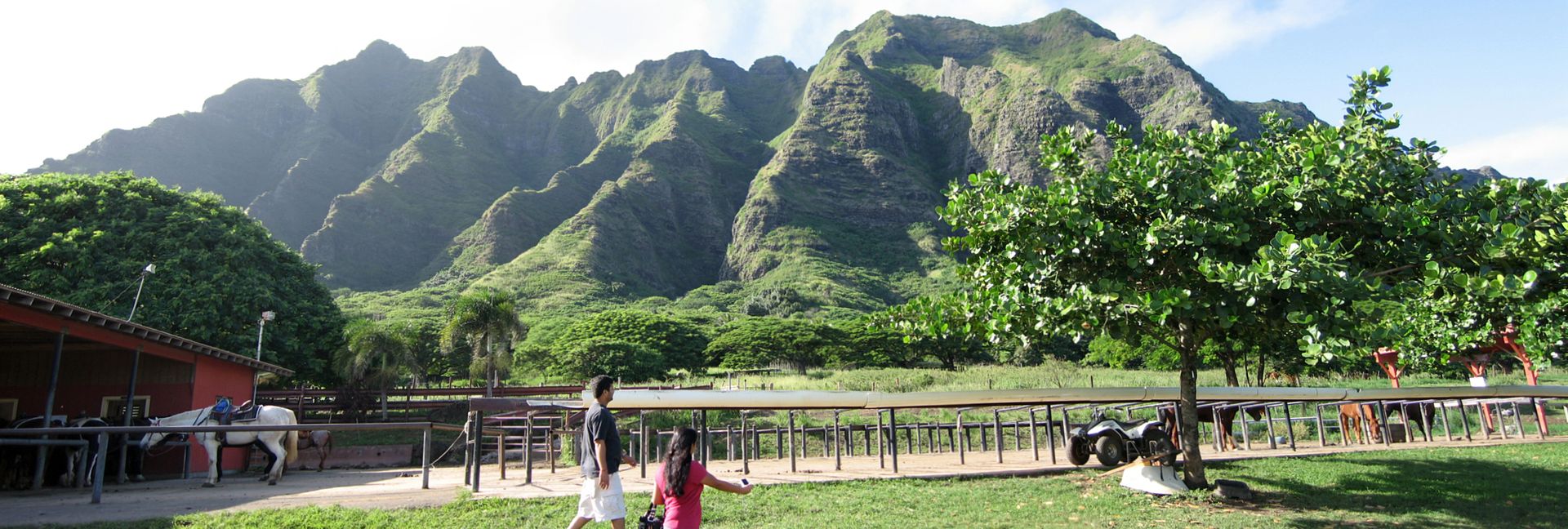
Kualoa Ranch
A 4000-acre private nature reserve and working cattle ranch, as well as a popular tourist attraction and filming location on the windward coast. It is located about 24 miles from Honolulu, and 32 miles from Haleiwa. The ranch consists of 3 valleys: Kaʻaʻawa Valley, Kualoa Valley, and Hakipu’u Valley.
The valley was sacred to ancient Hawaiians from the 13th to the 18th century, as Chief Laʻa-mai-kahiki settled there after visiting Kau’i before returning to Tahiti. It was also the site of the sacred drums of Kapahuʻula and Kaʻahuʻulapunawai as well as the sacred Hill of Kauakahiakahoʻowaha, the key to the sovereignty of the Kingdom of Oahu. As written in the Kumulipo, an ancient Hawaiian genealogical chant, Kualoa is where Papa and Wakea buried their first still born child, Haloa. It is said that the first kalo (taro) plant grew up from where Haloa was buried at Kualoa. In 1863, Charles Judd and his brother-in-law Samuel Garner Wilder started a sugarcane plantation and built a sugar mill at the ranch. Several years of low rainfall brought sugar farming to a close, and the mill closed in 1870. The ruins of the old sugar mill can still be seen along Kamehameha Highway. In 1941 during WWII, the U.S. military occupied the land, which became the site of Kualoa Airfield. After the war the ranch was returned to the Morgan family, the owners and descendants of Dr. Judd.
More than 50 movies and TV shows have been filmed at Kualoa over the years, including Paradise, Hawaiian Style, Jurassic Park, Jurassic World, 50 First Dates, You, Me and Dupree, Hawaii Five-o, Mighty Joe Young, Pearl Harbor, Windtalkers, Godzilla, Kong: Skull Island and Lost.

Honolulu Museum of Art
Formerly called the Honolulu Academy of Arts. The museum is largest of its kind in the state, and was founded in 1922 by Anna Rice Cooke. It has one of the largest single collections of Asian and Pan-Pacific art in the United States, and since its official opening on April 8, 1927, its collections have grown to more than 50,000 works of art.
It presents international caliber special exhibitions and features a collection that includes Hokusai, van Gogh, Gauguin, Monet, Picasso and Warhol, as well as traditional Asian and Hawaiian art. Located in two of Honolulu’s most beautiful buildings, visitors can enjoy cafés, gardens, and films and concerts at the theater. In 2011, The Contemporary Museum gifted its assets and collection to the Honolulu Academy of Arts; in 2012, the combined museum changed its name to the Honolulu Museum of Art. In 1990, the Honolulu Museum of Art School was opened to expand the program of studio art classes and workshops.
The Museum is open to the public Tuesday through Sunday. Admission is free to members, children and for some events, but otherwise a fee is charged. Some events and certain days offer free admission to all.
